Neve Michael
Neve Michael (Hebrew: נְוֵה מִיכָאֵל, lit. Michael's Haven)[2] also known as Roglit, is a moshav in central Israel. Located in the Adullam region and built upon an eminence in the far south-east end of the Elah Valley, close to where the historic fight between David and Goliath took place, it falls under the jurisdiction of Mateh Yehuda Regional Council. In 2018 it had a population of 832.[1]
Neve Michael | |
|---|---|
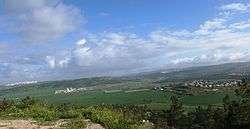 Neve Michael as viewed from hill overlooking Elah Valley | |
 Neve Michael | |
| Coordinates: 31°40′24.6″N 35°0′27.35″E | |
| Country | Israel |
| District | Jerusalem |
| Council | Mateh Yehuda |
| Affiliation | Hitahdut HaIkarim |
| Founded | 1958 |
| Founded by | Persian Jews |
| Population (2018)[1] | 832 |
History
The village was established on 29 July 1958 (12 Av 5718 anno mundi) by Kurdish immigrants from Iran on farm land that had belonged to the depopulated Palestinian village of Bayt Nattif.[3] The place had formerly been known as Khirbet Jurfah,[4] where archaeological finds point to a Jewish settlement dating back to the early Hellenistic period and early Roman period.[5] The newly restructured Jewish National Fund, working in concert with Hitahdut HaIkarim, settled new immigrants on the site in 1958, giving to the place the name Roglit (Hebrew: רוֹגְלִית), meaning "tiller [of the grapevine]". The new immigrants were initially employed as laborers for Jewish National Fund land reclamation. Afterwards, the village economy was based on agriculture (citrus fruit) and poultry, which phased out in the late 1980s. A newer regional community center built alongside it was given the name Neve Michael, in memory of American philanthropist, Michael M. Weiss, who was a donor to the Jewish National Fund.[6]
The newer section had a regional elementary school which catered to children from the surrounding communities of Roglit, Aderet and Aviezer, but closed its doors in the early 1980s. Today, the grounds of the old school serve as a home for the mentally and physically disabled. When the new settlement of Neve Michael failed to attract new residents, the settlement of Neve Michael was merged with Roglit in 1983.
A new Israel Border Police outpost was also built in Neve Michael, which was later abandoned after the Six-Day War, following the change in demarcation lines. The founders were joined by immigrants from North Africa, mainly Morocco.[7] In 2005 the village started an expansion plan attracting many younger families to the moshav. The moshav has a mixed population with people of different, ages, ethnic background and Jewish religious observance.
Within relatively short driving distances from the Moshav are the ruins known as Adullam and Hurvat Itri.
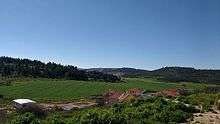
Gallery
 Vineyard at Neve Michael
Vineyard at Neve Michael View of Valley from the Moshav
View of Valley from the Moshav%2C_in_Israel.jpg) Sunrise over the Elah Valley
Sunrise over the Elah Valley Houses in Neve Michael
Houses in Neve Michael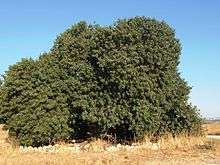 Terebinth tree (Pistacia atlantica) in the Elah valley, on south side of Neve Michael
Terebinth tree (Pistacia atlantica) in the Elah valley, on south side of Neve Michael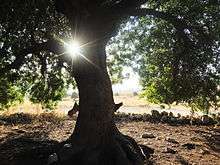 Beneath the shady boughs of a terebinth
Beneath the shady boughs of a terebinth- Terebinth (Pistacia atlantica) growing in the Elah Valley
 Wheat fields in the Valley of Elah
Wheat fields in the Valley of Elah.jpg) Almond tree with blossoming flowers
Almond tree with blossoming flowers The ruined structure of an ancient house, near Neve Michael
The ruined structure of an ancient house, near Neve Michael The Community Center in Moshav Neve Michael
The Community Center in Moshav Neve Michael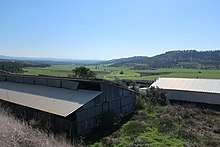 Neve Michael looking out over Wadi Sur
Neve Michael looking out over Wadi Sur Moshav as seen from eastern mountain
Moshav as seen from eastern mountain The eminence on which the village sits
The eminence on which the village sits.jpg) Wheat fields in valley
Wheat fields in valley
References
| Wikimedia Commons has media related to Neve Michael. |
- "Population in the Localities 2018" (XLS). Israel Central Bureau of Statistics. 25 August 2019. Retrieved 26 August 2019.
- English translation follows the Judeo-Arabic translation of the Hebrew "neve" = מאוא (مأوى), in Jeremiah 50:7, published in Yosef Tobi's Poetry, Judeo-Arabic Literature and the Geniza, Tel-Aviv 2006, p. 59 (Hebrew)
- Khalidi, Walid (1992). All That Remains: The Palestinian Villages Occupied and Depopulated by Israel in 1948. Washington D.C.: Institute for Palestine Studies. p. 212. ISBN 0-88728-224-5.
- In the Survey of Western Palestine (Arabic and English Name Lists), London 1881, p. 307, E.H. Palmer describes the site Khŭrbet Jurfa as "the ruin of the perpendicular bank (cut out by the torrent in the débris of a valley)."
- Avner, Rina (2006). "Rogelit". Hadashot Arkheologiyot: Excavations and Surveys in Israel. Israel Antiquities Authority. 118.
- Stone Monument in Neve Michael, in memory of Michael M. Weiss; In recognition of Michael M. Weiss
- About Neve Michael Homee (in Hebrew)